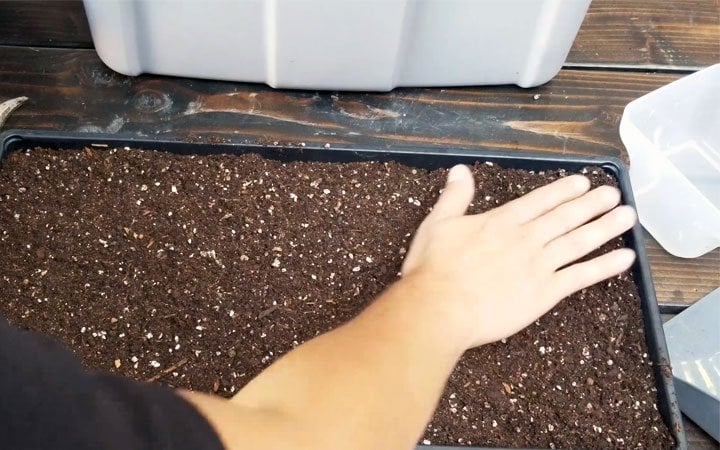There’s nothing better than having access to fresh, nutrient-dense salad greens that practically grow themselves, right?
I can already hear you saying, “Yeah, that’d be nice, if they existed…”
Well, they do, and they’re called microgreens.
Practically any plant can be grown as a microgreens, which is just the even-younger cousin of baby greens. Typically harvested around 8-20 days after planting, microgreens are the quickest turnaround crop you’ll ever grow in your garden.
Today, we’ll be growing lettuce or salad mix microgreens, which I consider one of the most basic types of microgreens you can grow, making them perfect for a beginner.
Listen to this post on the Epic Gardening Podcast
Subscribe to the Epic Gardening Podcast on iTunes
Lettuce / Salad Mix Microgreens Quick Info
- Flavor: Depending on the mix, can be either fresh and mild, or potent and spicy
- Soak – No
- Rinse / Drain – No
- Germination – 1-2 days
- Ideal Harvest – 8-12 days
I’ve filmed a full grow-along video below, but you can also follow the step-by-step guide with the materials list below — now let’s get to growing these greens!
Materials
Before we get into what you’ll need to grow lettuce microgreens, keep in mind these are just my recommendations to make the process a bit smoother. You can find a lot of these materials laying around your house as well, but if you want to invest in some equipment, here is what I recommend:
- Seeds: I got my seeds from True Leaf Market
- Containers: 10×20 plant growing trays
- Growing Medium: A 50/50 mix of organic potting soil and coconut coir)
- Light: 4′ T5 CFL grow light if growing indoors – check our T5 Grow Lights piece for suggestions
- Bonus: Spray bottle
Planting
Your first task is to prepare your trays properly. Don’t skimp out on the process here…proper tray prep will help you avoid all sorts of issues as your microgreens grow. My technique is to add 4 cups of water to the bottom of the tray, then fill with a 50/50 mix of coconut coir and a fine potting mix. You don’t want any large chunks of bark, stone, or other debris. The smoother and flatter the surface, the better!

For lettuce mix, I recommend 1 ounce of seed, spread evenly over the surface. You can use an old herb shaker if you want extremely even spreading, but even a simple drinking glass will work well. Avoid any clumping of seeds or uneven distribution…it’ll cause poor growth in those sections as the seeds germinate.

After you’re done spreading your seeds, mist the tray once more with your spray bottle and place another 1020 propagation tray on top. Leave it in a warm, dark area for 1-2 days, misting once or twice a day as needed. Be sure to check your trays daily for signs of mold growth, which is one of the biggest issues with microgreen growing.
Growing
After 2 days, most of your seeds should have germinated. Keep misting for another 2-4 days and grow your greens under the blackout dome. This period is crucial to get the greens up to a specific height before you take the dome off and expose them to light.
If you’re worried that your lettuce looks yellow…don’t be! Remember, it’s sunlight that turns a plant’s leaves green as it begins to photosynthesize.

After 4 days, you can take the blackout dome off and expose your greens to the light. Growing outdoors works just fine, but I prefer to keep mine indoors under LED lights to ensure I have a consistent environment for growing my microgreens. They will turn green after about 36 hours and will only keep growing taller and more healthy as you let them age!

You’ll know your lettuce microgreens are ready to harvest when you can see the first signs of “true leaves” develop. The first leaves that develop on your plants are actually the seed leaves…they were already formed inside the seed hull. This is why they don’t look like the normal leaves that would grow from a lettuce plant.
You can either harvest when you see the first sign of true leaves, or wait until these true leaves grow up a bit. Your yield will increase, but so will the time it takes to grow your tray.
Harvesting

There are many techniques for harvesting your microgreen trays. Some use knives, some use scissors, some commercial growers have specialized harvesting machinery. I find that grass shears work quite well, because the cutting blade is parallel to the surface of the tray. You can “mow down” your greens with ease.
Take care not to pull the roots out of the soil, and make sure to sacrifice about 1/2″ of stem just to make sure you don’t accidentally harvest any debris or seed hulls. The last thing you want to do is have to wash your microgreens. It damages them slightly and also decreases their storage life by about 30%!

Lettuce microgreens are dead-simple to grow and can be worked into a salad in absolutely no time at all. I recommend these five ingredients for the quickest preparation possible:
- Extra virgin olive oil
- Fresh-squeezed lemon juice
- Grated Parmesan cheese
- Salt
- Pepper
The olive oil and Parmesan cheese cut down on some of the spicier greens in the mix, adding a nice creaminess and fullness to the salad. Of course, feel free to add MUCH more to this salad…it’s just a basic one to get you started.
This post was sponsored by True Leaf Market, who provided the lettuce microgreen mix for me to test and grow.














